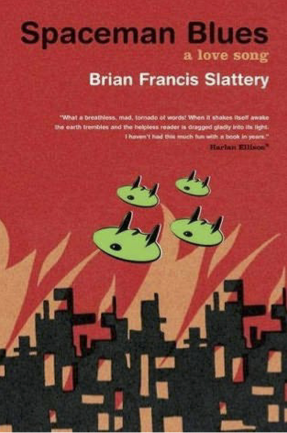
Prometheus
Newsletter of the LFS


The book opens with an explosion that tears out a huge chunk in the building where Manuel Rodrigo de Guzmán González lives. The police find no sign of a body, and Manuel appears to have no obvious enemies. Although stunned by the event, most of Manuel's friends (and he has many, many friends) believe him to still be alive, somewhere. His current lover, Wendell Apogee, begins a quest to find out what happened, and to locate Manuel.
The syncopated prose sketches a vibrant New York, in midsummer with a “sun that's already baking concrete, melting the antennae of cars.” In a city that feels more like Rio in its meld of music and masses, we're introduced to a host of strange and colorful characters. There's the man who lives on a boat, tracing the fates of interconnected individuals in strings hanging on the ceilings of his floating and well-stocked abode. He provides a critical clue to Wendell.
New York is a city of immigrants and teems with life. Manuel himself was an immigrant, as are the four Guatemalan lovers of another of Manuel's friends, all of whom work at the airport cleaning the runway, and thus can spot the trends of travelers and their moods. Masoud Azzi, a former fighter pilot for Syria now turned pacifist, joins Wendell on his quest, and regains his fire for life.
Others also are seeking Manuel. Officialdom appears as the strangely named inspectors Trout and Salmon. They interview and catalog, but appear to solve the mystery of the explosion and Manuel's disappearance. One of Manuel's enemies, or perhaps a competitor, specializes in smuggling illegal immigrants, shows that Manuel was far from a saint, and casts a shadow over Manuel's ethics. A clue early in the book mentions the new Church of Panic, whose members float above the pavement, and warn people to begin stockpiling weapons.
This is a clue readers should not take lightly, even though it fits neatly in the varied menagerie of the rest of New York's strange denizens. Do these members of the Church of Panic know something connected to Manuel's disappearance?
As we trace Wendell's journey through the city, even deeper into the bowels of an underground world, almost a mirror image of the one above, whisperings and rumors of four strange creatures appear. These massive humanoid beings fly through the skies on floating platform. Like relentless and seemingly unkillable Terminators, they pursue the trail of Manuel and those associated with him. Wendell begins to realize that the fate of Manuel and the arrival of these creatures somehow are tied together, and together with Masoud they begin a rigorous training course in martial arts and weaponry. Wendell emerges from his travails as a new super-hero, Captain Spaceman, who takes on these Four Horsemen. The first battle is like most such encounters—one in which he suffers defeat, but he survives and learns enough to fight another battle. What started as a mystery story about the disappearance of one person evolves into a more traditional sf story: a potential alien invasion. The tone of the novel also changes, becoming more somber than the initial party scenes and wild music. This trend continues to the book's ending, which casts both a despairing and optimistic tone, and a new future for Wendell; he has journeyed far.
In many ways Spaceman Blues is an anomalous science fiction novel. Published by Tor Books, a more “mainstream” sf publishing house, this novel feels more modernistic or slipstream-like, quite different from the hard sf for which Tor is best known. Spaceman Blues has drawn strong critical praise from fellow genre writers—a blurb from is featured prominently on the cover. The obvious sf elements tend to stay on the fringes until the very end. Still, the descriptions of New York City, of the strange inhabitants and their extraordinary abilities, these all could have taken place off-world, or in that strange super-hero reality that after all is welcomed as an integral node in the science fiction world.
's novel is quite amazing for a debut effort. It takes some skill to pull off the literary aspect of the book, and the final pay-off isn't that shabby either. Many recent movies (ie. I am Legend, Cloverfield) have pushed the theme that New York City must be destroyed. The novel concludes with a similar possibility; yet there is hope and life, passion and will emanating from the pages of this book that all harken to Pandora's Box, that hope might just be all we need. Spaceman Blues is a challenging book, yet unforgettable and ultimately rewarding.
|
All trademarks and copyrights property of their owners. |